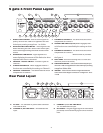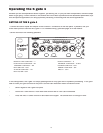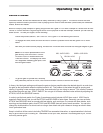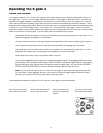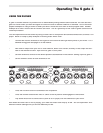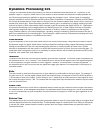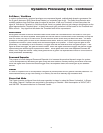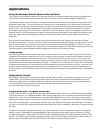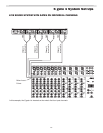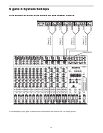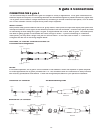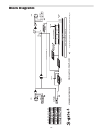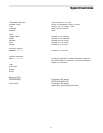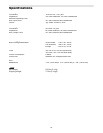
12
Applications
Using the Expander/Gate to Remove Hiss and Noise
The S gate 4 is an extremely useful tool in reducing the level of unwanted noises. By using the Expander/Gate
you can effectively fade the noise into the noise floor or abruptly turn the unwanted signal completely off.
Letʼs say you want to reduce the bleed or cross talk that occurs when different instruments are recorded in close
proximity to each other. You have recorded an acoustic guitar simultaneously in the same room as with some
other acoustic instruments. The problem is that you hear a lot of the other instruments playing when the acoustic
guitar is silent. This can cause phasing and comb filtering problems due to microphone placement, so having
the bleeding signal drop into the noise floor is desirable. To do this, set the S gate 4 to Expander mode with the
Release switch to Slow and adjust the Trigger so that the acoustic guitar signal is well above the threshold level.
When the signal from the acoustic guitar track falls below the threshold level, the signal subtly fades into the
noise floor.
Now letʼs say youʼre attempting to remove the pick-up noise and hum from a guitar track that was recorded
through a loud amplifier. The hum and noise is most noticeable in-between the rhythm of the performance, so you
want to have the gate close during the silent parts and open during the musical passages. To do this, set the S
gate 4 to Gate mode and adjust the Trigger level so that the gate is open just during the musical guitar parts, and
so that the gate is closed during the silent passages so that the hum and noise is muted.
Gating Drums
Using noise gates on drums is particularly useful in recording and in live sound. When a drum kit is set up with
individual microphones on each drum in a live PA system, thereʼs potential for great sound. However, there are
several gain management problems that can occur. Several microphones, like the ones on the tom-toms, will
only be used occasionally and until the time that the tom-tom is actually played, its microphone is merely picking
up unwanted sound from other instruments on stage. This adds a lot of unwanted mush in the mix and also adds
to feedback problems. Set the controls so that the gate opens only when the tom-tom is played. This same tech-
nique is useful on drums that have been recorded on individual tracks. By using the Gate to mute the bleed of
the other drums, you can effectively reduce the comb filtering produced by phase cancellation due to microphone
proximity.
Gating Longer Sounds
When using a noise-gate on sounds with a longer decay such as a piano, it is usually necessary to use a longer
release time. Run the piano signal through the S gate 4 and set the Expander/Gate Release switch to Slow.
Adjust the Trigger level on sustained passages to get the best results. Be sure to listen for the natural decay of
the instrument and allow the gate to remain open until just after the end of the decay.
Using a Noise Gate to Tighten Up the Mix
Using a Noise Gate to Tighten Up the Mix
S gate 4 can be used in mixing to clean up loosely played tracks, and even make a rhythm section sound tighter
than they really are. On a single instrument, like a rhythm guitar track, you can clean up the performance by gat-
ing the track. To do this, set a release time to exactly match the tempo of the music, so that you hear the guitar
playing, but stopping (gate closed) just before the beat. By doing this, a less than perfect rhythm track can quickly
sound like it was played by a great session guitarist. Also, pay attention to the space that the S gate 4 creates in
the track, since very often a great performance really jumps out when it is framed by the space, or silence around
the track.
To tighten up a group of instruments, patch in an S gate 4 channel on each instrument and dial in a good gate
setting on each. Now select the best performance from the group that you want to use as a master to control
the other instruments. Take the KEY OUTPUT from that channel and patch it into each the other channelʼs KEY
INPUT. The result is that the audio (performance and rhythm) from the master channel will key other channelʼs
gates to open and close so that the performance of all channels sounds exactly the same.



